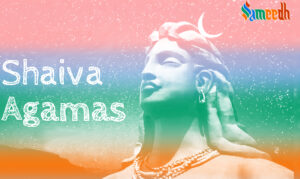The Makuta Agama is an ancient Hindu scripture, revered within the Shaiva tradition, that provides comprehensive guidelines for temple construction, rituals, and worship practices. In particular, it emphasizes the worship associated with the sacred crown (makuta) worn by the deity in the temple, with a special focus on Lord Shiv.

The history of the Makuta Agama, like many ancient Hindu scriptures, is intertwined with the broader tradition of Agama literature within Hinduism. Agamas are considered to be revealed texts, imparted by divine beings to their devotees, offering guidance on various aspects of temple construction, rituals, worship, and spiritual practices.
Specifically, the Makuta Agama is a scripture dedicated to Lord Shiv and is revered within the Shaiva Agama tradition. Its history likely extends back to ancient times when the practices and rituals associated with Shaivism were orally transmitted among priests and devotees. Over time, these teachings were organized, systematized, and committed to writing, leading to the composition of texts like the Makuta Agama.
The precise historical timeline and authorship of the Makuta Agama are challenging to ascertain due to the lack of concrete historical records. However, it is believed to have been composed over centuries through the process of oral transmission and later codification.
The Makuta Agama, like other Agamas, played a crucial role in shaping the religious and cultural landscape of Shaivism, particularly in South India, where Shaiva temples and traditions flourished. It provided a comprehensive framework for temple construction, deity worship, and spiritual devotion, guiding devotees in their religious practices and fostering a deep sense of connection with the divine.
In terms of its transmission and preservation, the Makuta Agama would have been passed down through generations of priests, scholars, and devotees within the Shaiva community. It would have been studied, memorized, and recited during temple rituals and ceremonies, ensuring its continuity and relevance across generations.
Today, the Makuta Agama continues to be revered and studied by Shaiva scholars and practitioners, serving as a source of guidance and inspiration for temple construction, worship, and spiritual practice within the broader Hindu community. While its historical origins may remain somewhat obscure, its teachings and principles remain vibrant and influential in contemporary Shaiva traditions.
Key aspects of the Makuta Agama include:
- Design and Consecration of the Crown: The Makuta Agama offers detailed guidelines for the design, consecration, and rituals related to the sacred crown worn by the deity. It outlines the specifications for the design of the crown, including its size, shape, and adornments, as well as the procedures for its consecration to invoke divine blessings and sanctity.
- Rituals and Worship: This scripture provides instructions for the performance of rituals and worship associated with the sacred crown. It delineates the procedures for offering prayers, mantras, and offerings to the deity while honoring the significance of the crown as a symbol of divine sovereignty and power.
- Emphasis on Lord Shiv: The Makuta Agama places particular emphasis on the worship of Lord Shiv, highlighting his role as the supreme deity within the Shaiva tradition. It provides devotees with guidance on how to conduct rituals and worship practices specific to Lord Shiv, including those related to the sacred crown.
- Relevance in Shaiva Siddhant Tradition: The Makuta Agama is highly regarded within the Shaiva Siddhanta Agamas tradition, a philosophical and theological school within Shaivism. It is considered an important scripture in the Yoga Agamas, which focus on spiritual discipline, meditation, and the attainment of spiritual liberation.
Overall, the Makuta Agama serves as a sacred guidebook for devotees and priests involved in the worship of Lord Shiv, offering insights into the significance of the sacred crown and providing detailed instructions for its design, consecration, and rituals.
